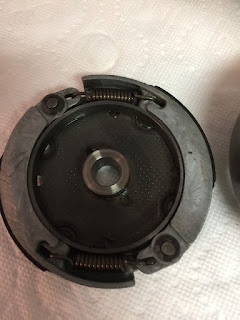Ryan M. posted a couple questions in the comments this summer:
Hi I'm setting up a very similar nc50 to yours with an Athena kit and vm20. What jetting size did you settle on for the Mikuni? On another note did you notice the massive size difference in depth of the side transfer ports compared to the casing. Did you have any issues with leaks around the gaskets here? Did you adapt your case port in any way.... there's not a lot of meat to work with there!
- Main jet is a 172.5
- It has whatever needle it came with, I did drop it down one position to make the needle a little leaner, so it is in the fourth clip.
- Pilot jet is whatever it came with.
- The air screw, I just play with until I got the best off idle response to opening the throttle. Weather affects the idle characteristics a good bit.
The main jet of 172.5 is rich for the engine, but I am using it as a bit of a bandaid against two bigger problems, head temperature and a mild case of detonation. The head I am using from http://treatland.tv, the Airsal 47.6mm Head has small cooling fins compared to the stock. Adding horsepower, adds more heat and in an air cooled engine, much of the heat from the combustion chamber is dissipated to the head and to the surface of the piston. I try to keep the peak head temperature, as measured at the spark plug using a Trail Tech Temperature Gauge, under 400F, even on the hottest days in Atlanta in stop and go traffic. When I first put the combination together, I could hear some bits of detonation and see some bits of carbon stripping from the plug. I went rich on the main jet and went to premium fuel. I have had some readings over 400F, but for the most part it is hanging in there. It's a 172.5 because it was a 180 and then next two smaller sizes I had were 172.5 and 165. Now that the weather is cooling off, I may drop it to a 165 and see how things are. When I pull the plug to look at it with the 172.5, its black, no white areas, so very rich. My gut says that 165 will still be rich.
For the most part, the low and mid range on the carb almost useless. There is so little time on these little scooters that you are at part throttle. I find that if I am stopped, I am mostly idling, and if I am moving, I mostly roll on full throttle and hold it there.
I tend to like the pilot jet rich, since you go from full throttle, full RPM to stopped, closed throttle, which deprives the engine of both cooling air and the generous lubrication it was getting at full throttle because of the oil mix. This has always been a problem for two strokes on long tracks and on the street. Leaving the pilot rich, gives it a little bit of oil, a little bit of fuel cooling as you are stopping at a stop sign.
Over the summer, I added a second base gasket, just to try to lower the compression a little bit and raise the exhaust port. I now feel like that was a mistake, I am battling the head bolts coming loose and I am re-torquing them every couple of weeks. I think the extra base gasket just makes the whole base gasket, cylinder, head gasket, head, too spongy and it works itself loose over time. Longer term, I want to heli coil the cases and maybe go to a 7mm diameter stud.
Have I seen leaks around the base gaskets, the transfer ports? No. When the head first started loosening up, I saw sponge coming out of the metal head gasket near the exhaust pipe.
Have I seen the mismatch in the side transfers vs the case? No, but you make me want to go look at that.































